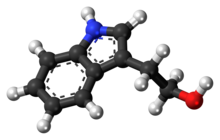Tryptophol

| |

| |
| Names | |
|---|---|
| Preferred IUPAC name
2-(1H-Indol-3-yl)ethan-1-ol | |
| Other names | |
| Identifiers | |
3D model (JSmol)
|
|
| ChEBI | |
| ChEMBL | |
| ChemSpider | |
| ECHA InfoCard | 100.007.632 |
PubChem CID
|
|
| UNII | |
CompTox Dashboard (EPA)
|
|
| |
| |
| Properties | |
| C10H11NO | |
| Molar mass | 161.204 g·mol−1 |
| Melting point | 59 °C (138 °F; 332 K) |
Except where otherwise noted, data are given for materials in their standard state (at 25 °C [77 °F], 100 kPa).
| |

Tryptophol is an aromatic alcohol that induces sleep in humans. It is found in wine as a secondary product of ethanol fermentation. It was first described by Felix Ehrlich in 1912. It is also produced by the trypanosomal parasite in sleeping sickness.
It forms in the liver as a side-effect of disulfiram treatment.[1]
Natural occurrences
[edit]Tryptophol can be found in Pinus sylvestris needles[2] or seeds.[3] It is produced by the trypanosomal parasite (Trypanosoma brucei) in sleeping sickness (African trypanosomiasis).[1][4] Tryptophol is found in wine[5] and beer as a secondary product of ethanol fermentation[6] (a product also known as congener) by Saccharomyces cerevisiae. It is also an autoantibiotic produced by the fungus Candida albicans.[7] It can also be isolated from the marine sponge Ircinia spiculosa.[8]
Metabolism
[edit]Biosynthesis
[edit]It was first described by Felix Ehrlich in 1912. Ehrlich demonstrated that yeast attacks the natural amino acids essentially by splitting off carbon dioxide and replacing the amino group with hydroxyl. By this reaction, tryptophan gives rise to tryptophol.[9] Tryptophan is first deaminated to 3-indolepyruvate. It is then decarboxylated[10] to indole acetaldehyde by indolepyruvate decarboxylase. This latter compound is transformed to tryptophol by alcohol dehydrogenase.[11]
It is formed from tryptophan, along with indole-3-acetic acid in rats infected by Trypanosoma brucei gambiense.[12]
An efficient conversion of tryptophan to indole-3-acetic acid and/or tryptophol can be achieved by some species of fungi in the genus Rhizoctonia.[13]
Biodegradation
[edit]In Cucumis sativus (cucumber), the enzymes indole-3-acetaldehyde reductase (NADH) and indole-3-acetaldehyde reductase (NADPH) use tryptophol to form (indol-3-yl)acetaldehyde.[14]
Glycosides
[edit]The unicellular alga Euglena gracilis converts exogenous tryptophol to two major metabolites: tryptophol galactoside and an unknown compound (a tryptophol ester), and to minor amounts of indole-3-acetic acid, tryptophol acetate, and tryptophol glucoside.[15]
Biological effects
[edit]Tryptophol and its derivatives 5-hydroxytryptophol and 5-methoxytryptophol, induce sleep in mice. It induces a sleep-like state that lasts less than an hour at the 250 mg/kg dose.[16] These compounds may play a role in physiological sleep mechanisms.[17] It may be a functional analog of serotonin or melatonin, compounds involved in sleep regulation.
Tryptophol shows genotoxicity in vitro.[18]
Tryptophol is a quorum sensing molecule for the yeast Saccharomyces cerevisiae.[19] It is also found in the bloodstream of patients with chronic trypanosomiasis. For that reason, it may be a quorum sensing molecule for the trypanosome parasite.[18]
In the case of trypanosome infection, tryptophol decreases the immune response of the host.[20]
As it is formed in the liver after ethanol ingestion or disulfiram treatment, it is also associated with the study of alcoholism.[1][16] Pyrazole and ethanol have been shown to inhibit the conversion of exogenous tryptophol to indole-3-acetic acid and to potentiate the sleep-inducing hypothermic effects of tryptophol in mice.[21]
It is a growth promoter of cucumber hypocotyl segments.[22] The auxinic action in terms of embryo formation is even better for tryptophol arabinoside on Cucurbita pepo hypocotyl fragments.[23]
See also
[edit]References
[edit]- ^ a b c Cornford EM, Bocash WD, Braun LD, Crane PD, Oldendorf WH, MacInnis AJ (1979). "Rapid distribution of tryptophol (3-indole ethanol) to the brain and other tissues". Journal of Clinical Investigation. 63 (6): 1241–1248. doi:10.1172/JCI109419. PMC 372073. PMID 447842.
- ^ Sandberg G (1984). "Biosynthesis and metabolism of indole-3-ethanol and indole-3-acetic acid by Pinus sylvestris L. Needles". Planta. 161 (5): 398–403. Bibcode:1984Plant.161..398S. doi:10.1007/BF00394569. PMID 24253838. S2CID 23500542.
- ^ Sandberg G, Ernstsen A, Hamnede M (1987). "Dynamics of indole-3-acetic acid and indole-3-ethanol during development and germination of Pinus sylvestris seeds". Physiologia Plantarum. 71 (4): 411–418. doi:10.1111/j.1399-3054.1987.tb02876.x.
- ^ Richard Seed J, Seed TM, Sechelski J (1978). "The biological effects of tryptophol (indole-3-ethanol): Hemolytic, biochemical and behavior modifying activity". Comparative Biochemistry and Physiology C. 60 (2): 175–185. doi:10.1016/0306-4492(78)90091-6. PMID 28889.
- ^ Gil C, Gómez-Cordovés C (1986). "Tryptophol content of young wines made from Tempranillo, Garnacha, Viura and Airén grapes". Food Chemistry. 22: 59–65. doi:10.1016/0308-8146(86)90009-9.
- ^ Ribéreau-Gayon P, Sapis JC (1965). "On the presence in wine of tyrosol, tryptophol, phenylethyl alcohol and gamma-butyrolactone, secondary products of alcoholic fermentation". Comptes Rendus de l'Académie des Sciences, Série D. 261 (8): 1915–6. PMID 4954284. (Article in French)
- ^ Lingappa BT, Prasad M, Lingappa Y, Hunt DF, Biemann K (1969). "Phenethyl alcohol and tryptophol: Autoantibiotics produced by the fungus Candida albicans". Science. 163 (3863): 192–4. Bibcode:1969Sci...163..192L. doi:10.1126/science.163.3863.192. PMID 5762768. S2CID 12430791.
- ^ Erdoğan İ, Sener B, Higa T (2000). "Tryptophol, a plant auxin isolated from the marine sponge Ircinia spinulosa". Biochemical Systematics and Ecology. 28 (8): 793–794. Bibcode:2000BioSE..28..793E. doi:10.1016/S0305-1978(99)00111-8. PMID 10856636.
- ^ Richard W. Jackson (1930). "A synthesis of tryptophol" (PDF). Journal of Biological Chemistry. 88 (3): 659–662.
{{cite journal}}: CS1 maint: numeric names: authors list (link) - ^ Dickinson JR, Salgado LE, Hewlins MJ (2003). "The catabolism of amino acids to long chain and complex alcohols in Saccharomyces cerevisiae". The Journal of Biological Chemistry. 278 (10): 8028–34. doi:10.1074/jbc.M211914200. PMID 12499363.
- ^ Pathway: tryptophan degradation VIII (to tryptophol) at BioCyc.org
- ^ Stibbs HH, Seed JR (1975). "Short-Term Metabolism of \14C]Tryptophan in Rats Infected with Trypanosoma brucei gambiense". Journal of Infectious Diseases. 131 (4): 459–62. doi:10.1093/infdis/131.4.459. PMID 1117200.
- ^ Toshiko Furukawa, Jinichiro Koga, Takashi Adachi, Kunihei Kishi and Kunihiko Syono (1996). "Efficient Conversion of L-Tryptophan to Indole-3-Acetic Acid and/or Tryptophol by Some Species of Rhizoctonia". Plant Cell Physiol. 37 (7): 899–905. doi:10.1093/oxfordjournals.pcp.a029037.
{{cite journal}}: CS1 maint: multiple names: authors list (link) - ^ Brown HM, Purves WK (1976). "Isolation and characterization of indole-3-acetaldehyde reductases from Cucumis sativus". J. Biol. Chem. 251 (4): 907–13. doi:10.1016/S0021-9258(17)33779-1. PMID 2607.
- ^ Laćan G, Magnus V, Jericević B, Kunst L, Iskrić S (1984). "Formation of Tryptophol Galactoside and an Unknown Tryptophol Ester in Euglena gracilis". Plant Physiology. 76 (4): 889–93. doi:10.1104/pp.76.4.889. PMC 1064400. PMID 16663965.
- ^ a b Cornford EM, Crane PD, Braun LD, Bocash WD, Nyerges AM, Oldendorf WH (1981). "Reduction in Brain Glucose Utilization Rate after Tryptophol (3-Indole Ethanol) Treatment". Journal of Neurochemistry. 36 (5): 1758–65. doi:10.1111/j.1471-4159.1981.tb00428.x. PMID 7241135. S2CID 9169087.
- ^ Feldstein A, Chang F, Kucharski J (1970). "Tryptophol, 5-hydroxytryptophol and 5-methoxytryptophol induced sleep in mice". Life Sciences. 9 (6): 323–9. doi:10.1016/0024-3205(70)90220-1. PMID 5444013.
- ^ a b Kosalec I, Ramić S, Jelić D, Antolović R, Pepeljnjak S, Kopjar N (2011). "Assessment of Tryptophol Genotoxicity in Four Cell Lines in Vitro: A Pilot Study with Alkaline Comet Assay". Archives of Industrial Hygiene and Toxicology. 62 (1): 41–49. doi:10.2478/10004-1254-62-2011-2090. PMID 21421532.
- ^ Wuster A, Babu MM (2010). "Transcriptional control of the quorum sensing response in yeast". Molecular BioSystems. 6 (1): 134–41. doi:10.1039/B913579K. PMID 20024075.
- ^ Ackerman SB, Seed JR (1976). "The effects of tryptophol on immune responses and its implications toward trypanosome-induced immunosuppression". Experientia. 32 (5): 645–7. doi:10.1007/BF01990212. PMID 776647. S2CID 12695689.
- ^ Seed JR, Sechelski J (1977). "Tryptophol levels in mice injected with pharmacological doses of tryptophol, and the effect of pyrazole and ethanol on these levels". Life Sciences. 21 (11): 1603–10. doi:10.1016/0024-3205(77)90237-5. PMID 600013.
- ^ Rayle DL, Purves WK (1967). "Isolation and Identification of Indole-3-Ethanol (Tryptophol) from Cucumber Seedlings". Plant Physiology. 42 (4): 520–524. doi:10.1104/pp.42.4.520. PMC 1086576. PMID 16656532.
- ^ Jelaska S, Magnus V, Seretin M, Lacan G (1985). "Induction of embryogenic callus in Cucurbita pepo hypocotyl explants by indole-3-ethanol and its sugar conjugates". Physiologia Plantarum. 64 (2): 237–242. doi:10.1111/j.1399-3054.1985.tb02342.x.
